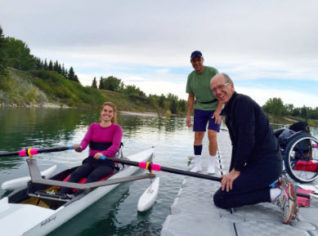Adaptive rowing or para-rowing (also called sculling) offers a low-impact activity, full body workout that can be performed by individuals of all fitness and functional levels – both on and off the water. For the most part, adaptive rowing or para-rowing equipment is standard equipment with minor modifications:
- Special seats with higher backs, which may include arms on sides and/or chest or leg straps
- Pontoons affixed to both sides of boats with brackets
Adaptive Rowing or Para-Rowing Classifications for Competition
As a competitive sport, para-rowing is unique. It is fully integrated with the World Rowing Federation, FISA, which means that para-rowers participate alongside able-bodied athletes at some of the World Rowing Cups and the World Rowing Championships.
There are three categories for adaptive rowers:
- PR3
- Rowers have use of at least one leg, trunk and arms
- Rowed with standard boats and sliding seats
- PR2
- Rowers only use of trunk muscles
- Boat has fixed seat
- PR1
- Rowers have limited trunk control
- Boat has fixed seat and rower is strapped at upper chest level to only allow shoulder and arm movements
Indoor and On-Water Adaptive Rowing (2:52)
Additional Resources
Guide to Adaptive Rowing – from US Rowing (PDF)
Adaptive Rowing Programs in the United States
Listed by state.
Learn about para sports events to get an idea about what’s out there and to find some ways to participate.


Leave a Reply